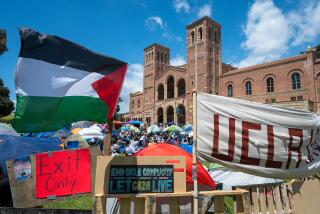Urban Studies Class : Students Get Educated on the Streets
Les Howard is making life uncomfortable for some of his Whittier College students, and he is pleased as punch about it.
Howard, a sociologist teaching urban studies, sent freshman Julie Tracy to observe parks in Los Angeles, and she wound up sharing a bench with a homeless man. “I’ll be honest,” recalled Tracy, who grew up in a small Alaskan town. “I was nervous. . . .”
Leah Henry, a political science major, was assigned to ride the bus and visit cafes scattered around Los Angeles. She had never taken the bus much, so when it came to finding the right route, she was a lost. “When I asked a driver for some help,” she said, “he just looked at me like I was crazy. . . .”
That was exactly freshman John Scott’s reaction to Angelenos after walking the city for nearly 12 hours studying various neighborhoods. “L.A. is full of a lot of weirdos,” he said.
Trip to Little-Known World
Howard takes delight in exposing students firsthand to the realities of a big city like Los Angeles. Since coming to Whittier College six years ago, he has attempted to take Sociology 287: A Workshop in Urban Studies out of the classroom and into the city. It is among the skyscrapers, in the ethnic neighborhoods and on the streets that Howard believes that the best lessons of all can be learned about what makes a city tick and who lives there.
And that, Howard believes, is important. “Whether you’re studying business, history or philosophy, you need to know how a city functions to understand why people behave the way they do,” Howard said.
For many of Howard’s students, the class has been an eye-opener--and in some cases unsettling. Most are strangers to Los Angeles--a city that, to the uninitiated, seems to have no beginning or end. The majority of Whittier students are white and come from the suburbs, and Howard’s class is no different. So venturing into the inner city is a trip into a little-known world.
On a recent field trip, the class visited Manual Arts High School, a predominantly black campus near downtown Los Angeles. Like others in Howard’s class, sophomore Lori Buehring said she felt “the eyes of the student body” were on her as she toured the inner-city campus.
“I’ve always lived where I was in the majority,” said Buehring, who grew up in Agoura Hills, a largely white community in a somewhat rural setting northwest of Los Angeles. “But at Manual Arts, we were definitely in the minority. . . . It was real different. But that’s why I took this course--to learn some things about how others, particularly those in the central city, live.”
Variety of Experiences
That is Howard’s aim. During the four-week class, the group participated in an anti-apartheid demonstration at the South Africa Consulate, collected clothing for the homeless in south Los Angeles and visited an artist in his loft above Skid Row in the Central City.
“A city has a rhythm and a texture that cannot be transmitted in a textbook,” Howard said. “You’ve got to get out (and) see it up close. . . .”
Howard’s approach has made his class one of the most popular. It is offered only at the beginning of the year, when the college switches from its normal class schedule to what campus officials call the “January inter-session.” For four weeks, students are enrolled in one class. For example, the biology department offers a trip to Baja California or Hawaii to study marine life, while the drama department has a course in live theater, with students often seeing three plays a week.
“It gives both faculty members and students a chance to go a bit deeper into the material they are examining because they are concentrating full time on one subject,” campus spokesman Donald L. Stewart said.
Flop in an Easy Chair
Students in Howard’s urban studies course rarely see a classroom. The lecture hall is Howard’s living room where students pull up a pillow or flop in an easy chair. Several pots of coffee are always brewing.
“The students sit in classrooms eight months a year,” Howard said. “I try to offer an alternative, something that will get their creative juices flowing.”
David Donlevy, a freshman business major, believes it works. He said he has friends going to California State University, Fullerton, or California State University, Long Beach, who sit in lecture halls with several hundred other students. “You’re just a number there,” he said, sitting on Howard’s living room floor during a break in class. “But here, it’s different. Because we all go through some strange experiences together, we become a family of sorts. It’s personal. It has more impact. . . .”
More to Read
Sign up for Essential California
The most important California stories and recommendations in your inbox every morning.
You may occasionally receive promotional content from the Los Angeles Times.









